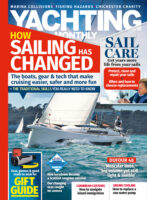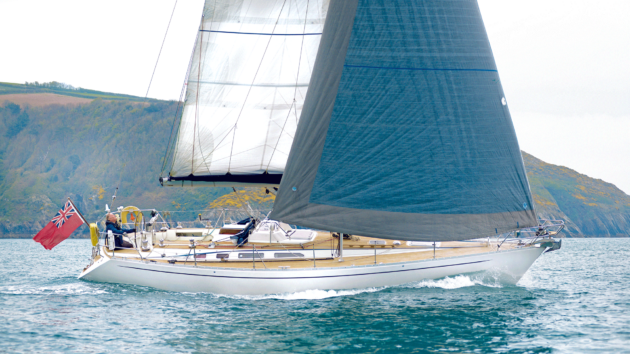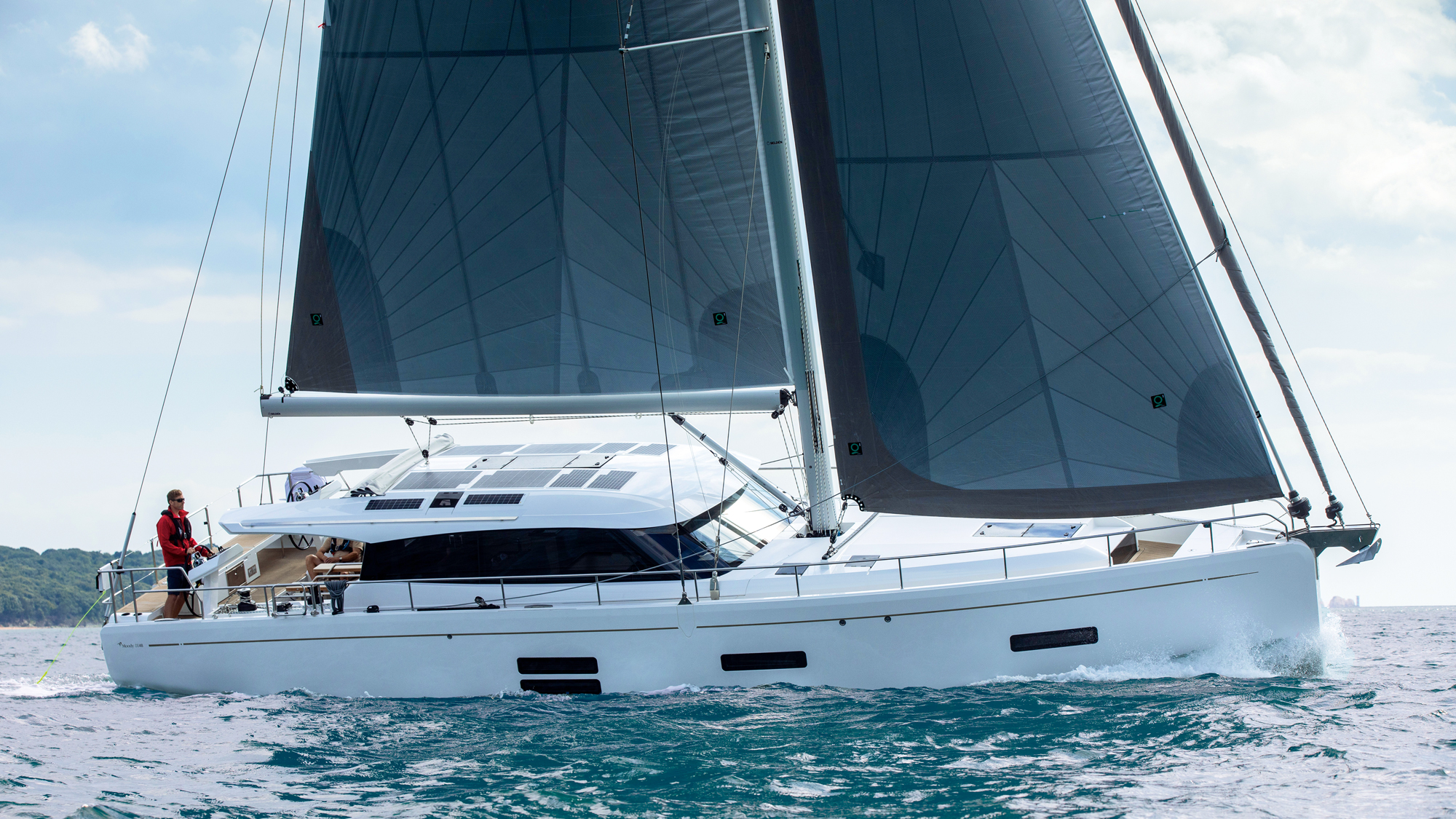With its comfortable accommodation and exhilarating turn of speed, this beautifully built Sweden Yachts 390 is becoming an increasingly affordable option in the used boat market
Used Sweden Yachts 390 Review: This Swedish Classic Still Turns Heads
The forecast did not look promising as we headed out of Dartmouth. A bit of sun, a bit of cloud, and a southeasterly Force 2-3. Not an ideal day for photos after all, but still we pressed on. As we passed by the castle at the mouth of the harbour, the sea was glassy calm. Perhaps we had better call it off and head back into Dartmouth for a coffee, I thought.
Then, as Rising Sunne passed by Newfoundland Cove, something magical happened. Her sails filled, she heeled over a little, pushing into the swell, and suddenly she was sailing at 3-4 knots. I couldn’t quite believe what I was seeing as the boat slid along, past the camera boat, purposefully with almost no breeze that I could make out. Even when I eventually climbed on board and we headed out to sea, Rising Sunne sped along at over six knots, even though the sea around us still looked flat calm.
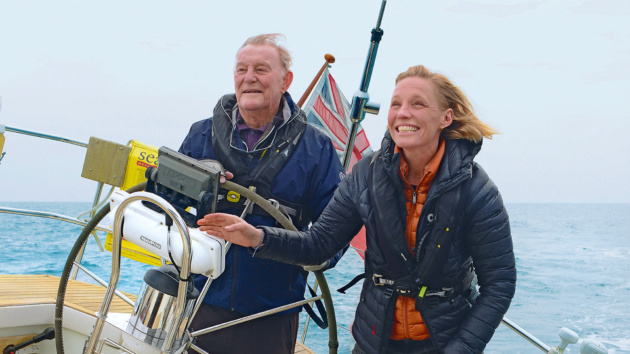
Nick Royle and his daughter Jo. Photo: Nic Compton
It turns out that this unexpected turn of speed in next to no wind was no fluke – Rising Sunne has won her class in the last two passage races from Torbay to Dartmouth in mostly light breezes. And that was against a whole raft of eminent names, including a Najad 332, a Hallberg-Rassy 412, a Contessa 38, an Arcona 400, a Bavaria 37 and a couple of Southerlys. She might look like a classic cruiser/racer from the 1990s, but she can still certainly pack a punch.
Growing family
The IOR (International Offshore Rule) racing metric was already on the way out when the first Sweden Yachts 390 was launched back in 1991 – yet the influence of the rule on the boat’s design is evident. For many of us, brought up on cruiser-racers of that era, the IOR shape with its exaggerated curves and fine ends is simply how a sailing yacht should look. Modern yachts look stumpy by comparison.
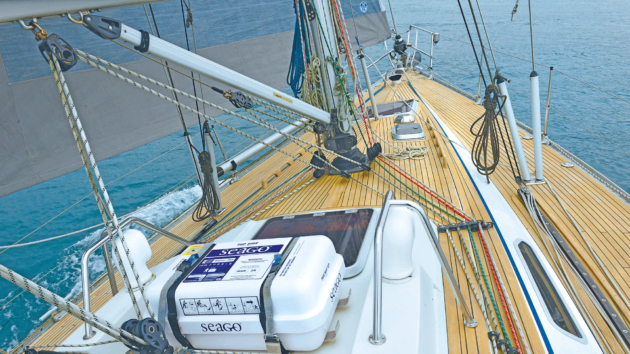
There’s acres of wood on deck, treated annually with Semco. Photo: Nic Compton
‘Your eye gets used to new boat designs over time, just like it does with cars,’ says Nick Royle, who shares the ownership of Rising Sunne with his daughter Jo. ‘Some designs look dated after a few years, but I think this boat still looks stylish. It’s got great lines – a bit Swan-ish, but without the Swan price! ‘If I want to feel good, I fold the sprayhood down, drop the anchor in a bay somewhere, then go for a walk and look down on her, and I think to myself, “Doesn’t she look great?”’
Nick started his boating life racing dinghies off the beach at Lytham, on the west coast of Lancashire, just south of Blackpool. His first yacht was a second-hand Hurley 24, which he bought in the late 1980s and based at Dart Marina in Dartmouth, where he and his wife Sue had acquired a holiday home. Remarkably, the couple have moored all their boats there ever since. Sue wasn’t a natural sailor but went along with Nick’s passion, as long as she could jump ship occasionally and book into a local hotel along the way.
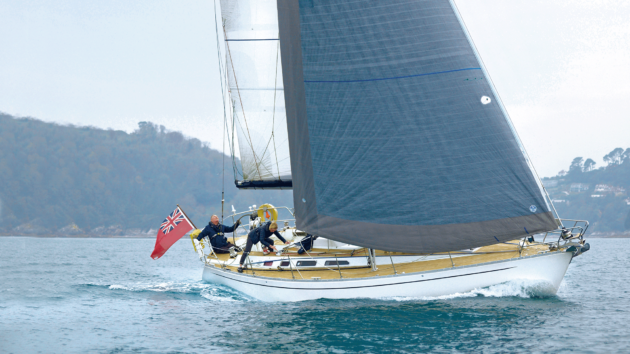
The classic IOR shape: wide beam amidships and fine ends. Photo: Nic Compton
‘The Hurley was a cheap boat, and everything kept breaking,’ recalls Nick. ‘I remember one time when I was on the foredeck, hanking on the sails, and I shouted to Sue to, “Head into the wind – head into the WIND!” But when I looked back, there was no-one there. I went aft and she’d gone down below. She said, “I’m not going to be spoken to like that!”’
Their next boat was a larger 33ft Westerly Storm, to accommodate their growing family of three children: Jo, Charlie and Ed. They cruised this boat extensively along the south coast of England, the Channel Islands and the north coast of France, although Nick admits it was probably a bit more ‘lively at times’ than strictly necessary. ‘I’ve always bought boats that were a bit too lively because I like a boat that sails well,’ he insists.
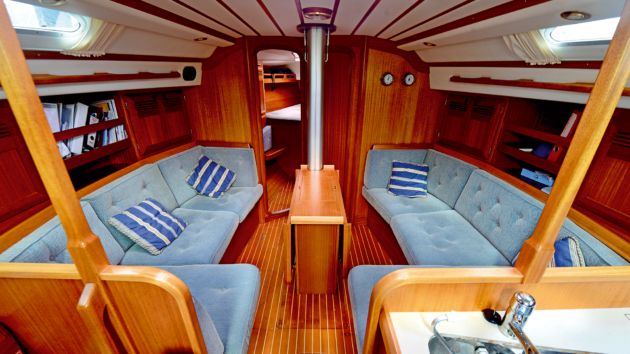
The interior has stood the test of time well. Photo: Nic Compton
By the early 2000s, Nick’s family were ready to buy a new boat but, at that year’s boat show, were torn between two possible contenders. ‘The Sweden Yachts 390 looked great but was too much money,’ remembers Nick, ‘so we looked at the Bénéteau 411, which was a nice, roomy boat. But then I had another look at the Sweden 390, and thought, “there’s no comparison”. So we stretched our budget! The interior was so well-built, and it has weathered extremely well over the years.’
Article continues below…
Westerly Konsort review: a re-purchase 40 years on
When fellow sailing instructor Liz Le Mare invited me aboard her recently acquired boat, I didn’t need much persuading. She’d…
Moody DS48 review: We sail this new yacht across the English Channel to see if she has what it takes
High topsides, muscular bow sections and a formidable deck house make the Moody DS48 an imposing sight, even standing alongside…
Decision to buy a Sweden Yachts 390
The family collected their new boat from the Sweden Yachts factory in Stenungsund on the west coast of Sweden on Midsummer’s Day 2005. It was a national holiday so they joined in with the festivities – although Nick was startled at one point to see Sue swinging a large double-bit axe as part of an axe-throwing competition.
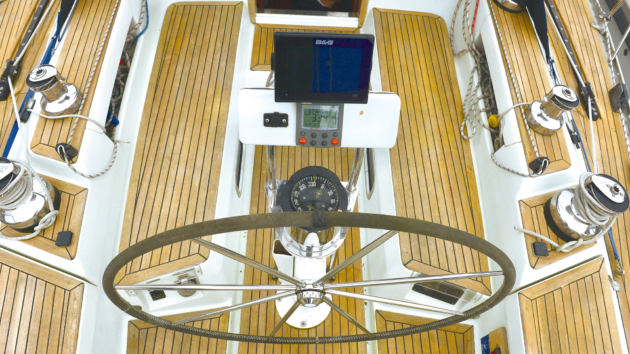
The wheel splits the cockpit into two parts. Photo: Nic Compton
They named the boat Rising Sunne after a poem by John Donne (The Sunne Rising) which celebrates the pleasures of lying-in in the morning! The boat has stood them in good stead ever since, with cruises to France, Spain, the Balearics, Corsica and Sardinia, as well as more local stuff. They’ve made remarkably few changes to the original spec, apart from fitting a secondary screen for the chartplotter on the steering pedestal and replacing the old Volvo 40 saildrive with a new Volvo 50 saildrive.
The old engine had got damaged while the boat was on delivery and the cost of fixing it was almost the same as fitting a new engine, so they decided to go for a new one. As the 40hp model was no longer available, they fitted the 50hp version which was only slightly larger than the original. Although it took a bit of jiggery-pokery to make it fit, they have no regrets. ‘That extra bit of power makes all the difference,’ says Nick.
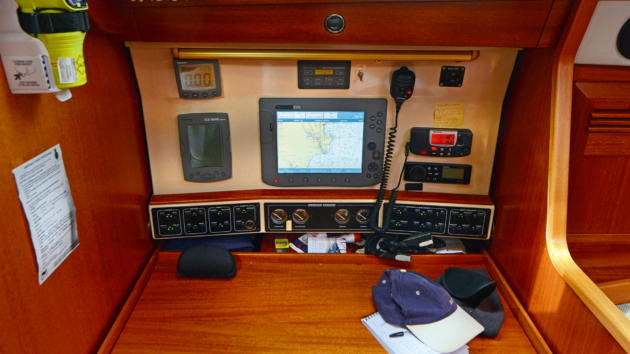
Facing outboard, the chart table faces outboard, with moderately recent electronics. Photo: Nic Compton
Meanwhile, despite being so seasick when she started sailing that she had to be lashed to the stern of the Westerly Storm, daughter Jo took up a career as a professional sailor. It started with boat deliveries (she was on board the West Country trading ketch Irene when the boat caught fire in Antigua in 2003 and helped with the subsequent rescue effort), followed by a stint at Clipper Venture in Gosport, where she was spotted by sailing sponsor Andrew Pindar.
For several years, Jo raced on Mini Transats, Class 40s and Open 60s under the Pindar banner. In 2008 she was recruited to lead the Plastiki expedition, during which a raft was built out of 12,500 plastic bottles and sailed across the Pacific from San Francisco to Sydney to raise awareness of plastic pollution. She’s worked as an environmental campaigner ever since, recently moving to Dartmouth, where she sails Rising Sunne with her father.
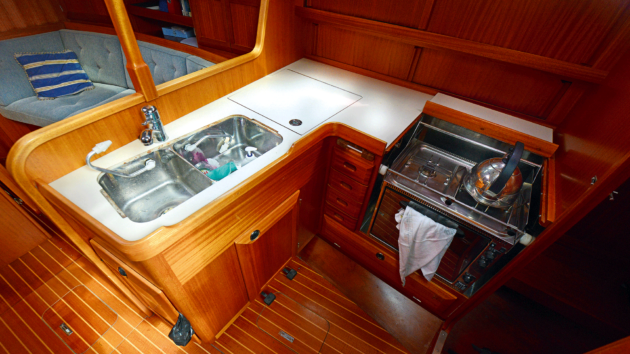
A solid, well designed galley with ample stowage. Photo: Nic Compton
Modern touches
I joined Nick and Jo on board Rising Sunne at the 100-berth Dart Marina – the only marina actually located in Dartmouth. With her almost flush decks and wedge-shaped cabin sides, creating a sleek low profile on top of that curvaceous hull, the boat bears obvious similarities with the Swans of the 1970s and 80s. And there’s nothing wrong with that!
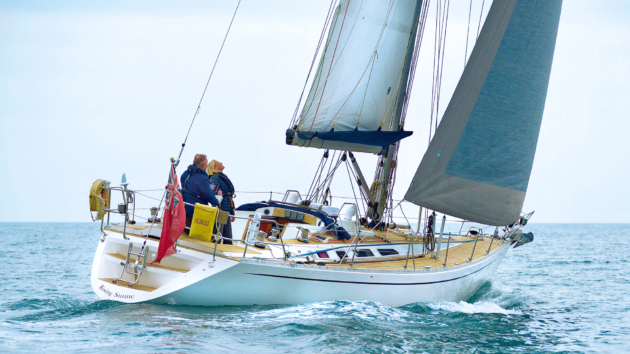
The scoop stern is now ubiquitous on most yachts. Photo: Nic Compton
Like many much older classic boats, there are some designs that remain timeless and the Sweden Yachts 390 is one of those. There are, nevertheless, still plenty of modern touches, such as the swimming ladder and boarding platform set into the transom – a definite sign of things to come, in terms of yacht design.
Rising Sunne’s teak decks had recently been scrubbed and treated with Semco sealer, so my first impression when I climbed on board was of a lot of wood – and then of her size. That 12ft 9in beam on a 39ft hull (an almost 1:3 beam to length ratio) makes her feel bigger than she really is. Even sitting at the dock she felt like a powerful boat.
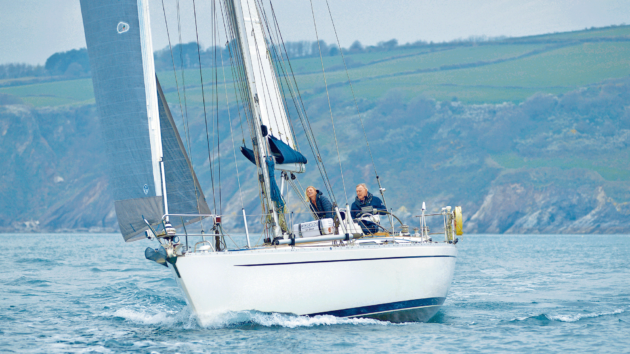
The Sweden 390 has classic good looks. Photo: Nic Compton
Practically speaking, there’s a lovely clear foredeck with plenty of space to stow sails, pump up dinghies, coil ropes, or whatever. Stowage lockers are on the small side – although I liked the neat stowage holes for sheets set into the cockpit coamings under the winches.
Below decks, there was even more wood. Swedish boats are famous for their lavish joinery, and Sweden Yachts were no exception. The 390 feels particularly welcoming, with its large open-plan area – the galley, chart table and saloon take up the widest third of the boat – and the curved saloon seating, echoing the shape of the hull going forward.
Once again, that ample beam makes her feel like a bigger boat below decks too. Perhaps the cream lining looks a bit dated, compared to the crisp white vinyl on some modern yachts, and the portholes are smaller, making it a bit darker than her contemporary sisters. But generally the interior has stood the test of time remarkably well.
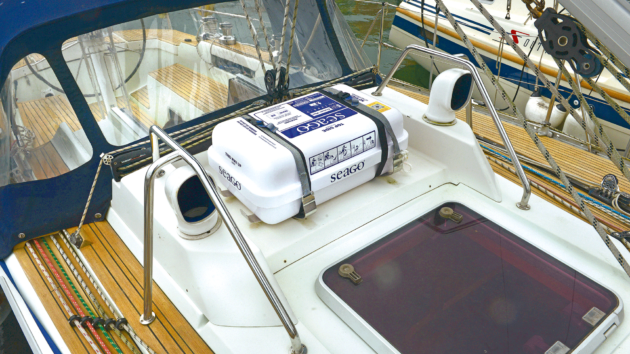
The rails protect the air vents. Photo: Nic Compton
The 390 was available with either a double and a single guest cabin on either side of the cockpit, or a double cabin and a heads. Rising Sunne has the two cabins aft, with a single heads forward, next to the large forward cabin. Two more can sleep in the saloon – and Nick often does because he likes ‘to know what’s going on’.
The layout suited the Royles when they sailed as a family and with young friends, but Nick finds that as he gets older (he’s 76 this year) his friends increasingly prefer to have their own heads, so the alternative layout would probably suit him better now. ‘It’s swings and roundabouts,’ he says.
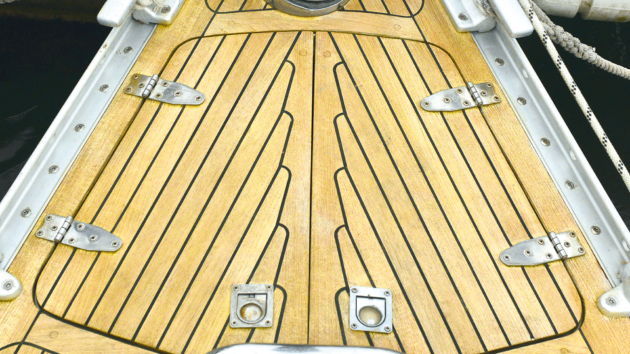
Good easy access to the bow storage. Photo: Nic Compton
Alternatives to Consider
Bénéteau 411
This was the alternative the Royles considered, and very nearly bought, before settling on their Sweden Yachts 390. And it’s not hard to see why they were seduced by its spacious, modern look and family-orientated design.
Indeed, they weren’t the only ones: the Bénéteau 411, in its various forms, was the company’s best-selling design, selling 1,200 boats in just eight years, which equates to 150 boats produced per year, or around three boats a week. No wonder the model Nick and family looked at was called the Bénéteau 411 Celebration.
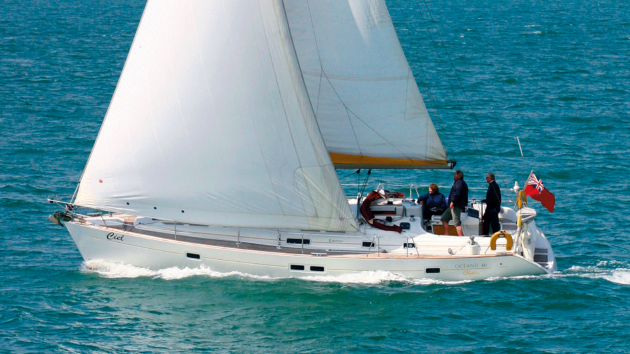
The large cockpit of the 411 is a plus for family sailing. Photo: David Harding
The Bénéteau 411 has a more modern shape than the SY390, carrying its maximum beam much further aft to free-up space for two double cabins in the stern, as well as creating a big, family-friendly cockpit.
However, the layout had its own limitations: the two aft cabins option meant the galley was on the port side opposite the saloon, and the comfy settee was replaced by a central bench. The single aft cabin option, on the other hand, meant you had a settee on the port side of the saloon, with the galley aft, but you lost a cabin. Both versions had two heads as standard, which would have pleased Nick now.
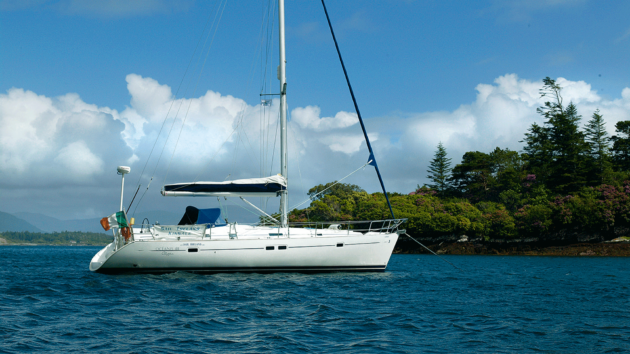
Bénetéau’s 411 was a big seller. Photo: Graham Snook/YM
Interestingly, the Bénéteau 411 came with a 50hp saildrive as standard, apart from the USA where a 40hp engine was standard. Electric winches were an optional extra – something to look out for if you’re considering buying second-hand.
In aesthetic terms, the two boats were worlds apart, with the Bénéteau 411 boasting acres of plastic above deck and a more pared back, modern interior.
The Bénéteau 411 Celebration, incidentally, was built with a blue hull, which looked smart when new but proved a lot more work to maintain. Although the Bénéteau 411 sold almost 17 times as much as the SY390, its design was practical rather than beautiful. Nowadays, the market is flooded with second-hand 411s which sell for around £10-20,000 less than an equivalent SY390 – something which will please owners of the rarer, and therefore more sought-after, Sweden Yachts. Their investment has paid off.
Starlight 39
‘Sadlers have come as close as is possible to producing the ideal modern 39 footer,’ Yachting Monthly once wrote about the Starlight 39 (previously known as the Sadler 38 and then the Starlight 38). And it’s certainly hard to find anyone who has a bad thing to say about these medium-displacement cruising-racers. The main gripe seems to be that too few were built – a mere 34 of them hit the water, as construction passed from Sadler Yachts to Sadler International to Rival Bowman over the years.
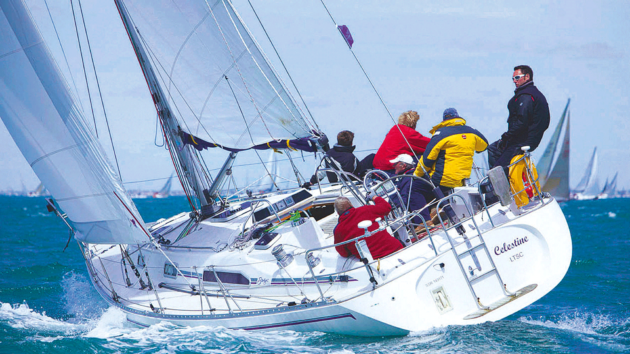
The superb sailing Starlight 39 is hard to find. Photo: David Harding
The design by Stephen Jones certainly hits a sweet spot between the more traditional hull shapes of the Contessa stable, the extremes of IOR, and the advent of the modern flat-bottomed wave surfers. The Starlight 39’s more moderate hull shape is reputed to be extremely sea-kindly and yet not slow – speeds of up to 16 knots have been claimed, more than once! More verifiably, the YM Used Boat test of March 2010 clocked 7.8 knots to windward, with a tacking angle of 70 degrees, and 6.6 knots off the wind.
The hull shape is less extreme than the SY390, with the beam carried further aft, giving more space below decks. But the full-length hull lining is said to reduce accommodation space.
The standard layout had two heads, sacrificing the third cabin which some SY390s (including Rising Sunne) benefitted from. The low-profile coachroof gives good visibility forward while a bridge deck provides headroom in the aft cabin.
The design was available with a deep fin keel or a shallower wing keel, said to be slightly slower but more comfortable at sea. At a fraction under 9 tonnes, expect a steadier ride than the Sweden Yachts 390.
Moody s38
The S38 was Moody’s attempt to move away from their reputation for producing safe but rather staid cruising yachts and to branch out into the performance cruiser arena. They brought in Bill Dixon to produce a more sporty design to follow on from the successful Moody 31 launched two years earlier – although the resulting 38-footer still erred more towards the comfortable than the truly competitive.
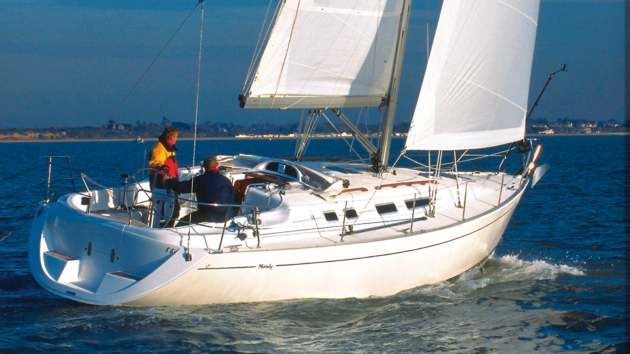
Moody 38 scores on accommodation. Photo: Latitudes Picture Library
Displacement is heavier than the Sweden Yachts 390 but lighter than the Starlight – though I suspect the SY390 would sail rings around the Moody S38.
That said, the beamier design made it possible to squeeze in a large owner’s cabin (or two doubles) aft, giving both cabins en suite heads. The high topsides and extra beam create a spacious interior – the saloon is said to be voluminous and with a high standard of joinery – even if the boat looks a lot boxier as a result than both the SY390 and the Starlight 39.
The S38 was available with a deep or shoal-draft fin keel, and with a standard masthead rig or a fractionally-rigged Sports version, with a taller mast. Even with the extra 75ft2 sail area of the Sports rig, however, the boat still carries 37ft2 less than the SY390. As with the SY390 and the Starlight 39, numbers are limited, as only 60 Moody S38s were built – not to be confused with the earlier (centre cockpit) Moody 38, of which 160 were built.
Cleverly, the S38 was originally priced at £20,000 less than the Starlight 39, while maintaining a similar standard of build. Nowadays, the boats sell second-hand for about the same price.
Enjoyed reading this?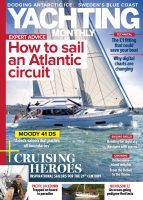
A subscription to Yachting Monthly magazine costs around 40% less than the cover price, so you can save money compared to buying single issues.
Print and digital editions are available through Magazines Direct – where you can also find the latest deals.
YM is packed with information to help you get the most from your time on the water.
-
-
- Take your seamanship to the next level with tips, advice and skills from our experts
- Impartial in-depth reviews of the latest yachts and equipment
- Cruising guides to help you reach those dream destinations
-
Follow us on Facebook, Twitter and Instagram.
Note: We may earn a commission when you buy through links on our site, at no extra cost to you. This doesn’t affect our editorial independence.
Verdict
With all that joinery below decks, not to mention the usual modern conveniences of a cruising yacht (such as nav gear, hot water, fridge, heating and so on) you might think the Sweden Yachts 390 would be a heavy boat. However, at 16,755 lb (7,600kg), she is at the lighter end of the spectrum for a boat her size. The Bavaria 390 weighs 17,637 lb (8,000kg) while the Hallberg-Rassy 39 is a mighty 22,046 lb (10,000kg). You have to go to the cheaper French boats, such as the Cyclades 39.3 and the Sun Odyssey 39, to find anything as light as (and lighter than) the SY390. It’s this relative lightness combined with a buoyant hull shape and a 5ft 9in deep wing keel (instead of the standard 7ft 4in fin keel) which makes her so quick in light airs. There’s not a lot of boat in the water, so she skims across the surface with surprising ease for a 39-footer. Yet, when I took a turn to steer, the helm felt solid – ‘Solid like a Swan,’ as Jo put it – and it inspired confidence. Although Jo was once a professional race skipper, once we get under way it’s clear that Nick is at least as competitive as she is, always tweaking the lines to get the most out of the boat. ‘It’s never fast enough for Dad,’ explains Jo. ‘He always thinks we could go a little bit faster.’ My instincts tell me that, in the perpetual trade-off that goes into every yacht design, a boat that performs well in light airs won’t do so well in heavy weather – particularly going to windward when you’d think the big waves would have her for breakfast. Yet I can’t find any evidence of this in sailing reports about the boats. More to the point, both Nick and Jo are serious sailors, and I can’t believe they would have kept a boat for 20 years if it didn’t perform well in a blow. ‘She’s fine in rough weather and always feels safe,’ says Nick, ‘although you do have to concentrate.’ One clear drawback of the saildrive/spade rudder combo is the lack of skeg, which leaves the rudder exposed to passing debris. The danger of this was illustrated a few years ago when a Sweden 390 lost its rudder after colliding with a container while crossing the Atlantic. The crew managed to rig up an emergency steering system using an improvised drogue made of an anchor, chain and fenders. They then sailed a further 1,500 miles to St Lucia, a remarkable feat in itself. The Sweden Yachts 390 won’t be everyone’s cup of tea – she has too strong a personality to please everyone. But for the discerning sailor there’s a lot to like: she’s a timeless modern classic with a surprising turn of speed, comfortable accommodation and a big heart. Not only that, but as the design goes into its fourth decade, the boats are becoming affordable to a new range of sailors who until now could only dream of owning a Sweden Yachts. So, now’s the time to make that dream come true.

